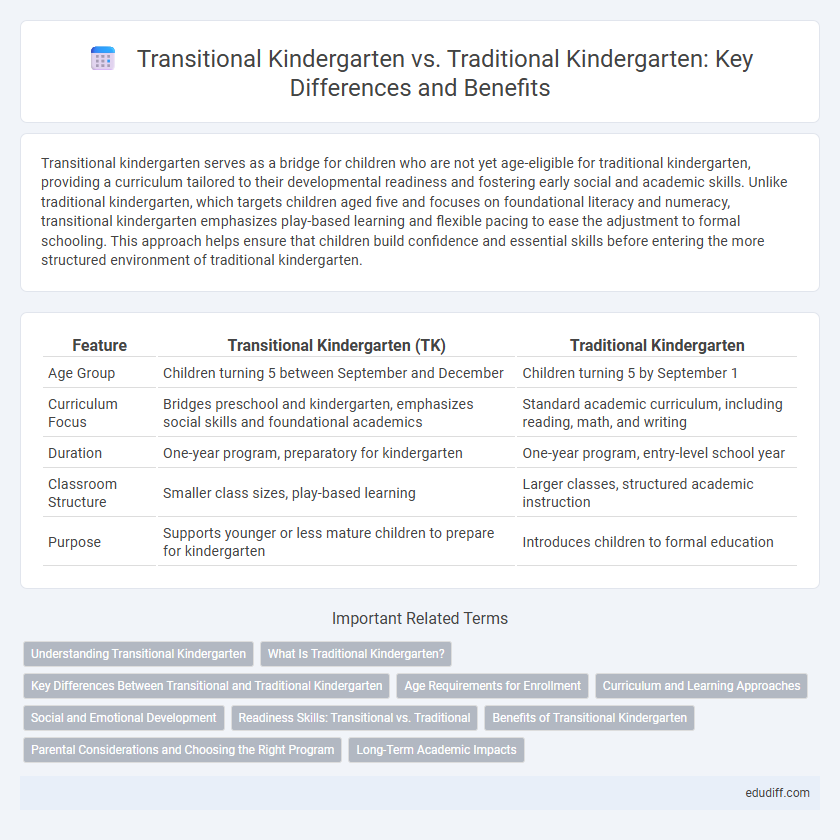Transitional kindergarten serves as a bridge for children who are not yet age-eligible for traditional kindergarten, providing a curriculum tailored to their developmental readiness and fostering early social and academic skills. Unlike traditional kindergarten, which targets children aged five and focuses on foundational literacy and numeracy, transitional kindergarten emphasizes play-based learning and flexible pacing to ease the adjustment to formal schooling. This approach helps ensure that children build confidence and essential skills before entering the more structured environment of traditional kindergarten.
Table of Comparison
| Feature | Transitional Kindergarten (TK) | Traditional Kindergarten |
|---|---|---|
| Age Group | Children turning 5 between September and December | Children turning 5 by September 1 |
| Curriculum Focus | Bridges preschool and kindergarten, emphasizes social skills and foundational academics | Standard academic curriculum, including reading, math, and writing |
| Duration | One-year program, preparatory for kindergarten | One-year program, entry-level school year |
| Classroom Structure | Smaller class sizes, play-based learning | Larger classes, structured academic instruction |
| Purpose | Supports younger or less mature children to prepare for kindergarten | Introduces children to formal education |
Understanding Transitional Kindergarten
Transitional Kindergarten (TK) serves as a bridge between preschool and traditional kindergarten, offering a modified curriculum designed for children who turn five years old between September and December. TK focuses on developing early literacy, social-emotional skills, and foundational math concepts through play-based and individualized instruction. This program provides additional time for children to adjust to school routines and build readiness skills before entering traditional kindergarten.
What Is Traditional Kindergarten?
Traditional kindergarten is an early childhood education program designed for children typically aged five, focusing on foundational skills in literacy, numeracy, socialization, and fine motor development. This curriculum emphasizes structured learning activities, group play, and teacher-led instruction to prepare children for first grade. Unlike transitional kindergarten, which targets younger or late-birthdate children needing an extra preparatory year, traditional kindergarten follows a standard academic calendar and developmental milestones.
Key Differences Between Transitional and Traditional Kindergarten
Transitional kindergarten serves as a bridge for children who are not yet age-eligible for traditional kindergarten, offering a modified curriculum focused on early literacy, social skills, and developmentally appropriate learning. Traditional kindergarten follows a more structured curriculum aligned with state standards, emphasizing reading, writing, math, and social studies to prepare children for first grade. Key differences include the age eligibility, pace of instruction, and emphasis on foundational skills versus academic readiness.
Age Requirements for Enrollment
Transitional kindergarten typically enrolls children who turn five years old between September and December, providing a bridge for those not yet age-eligible for traditional kindergarten. Traditional kindergarten generally requires children to be five years old by a specific cutoff date, often September 1st, to begin enrollment. This age distinction ensures appropriate developmental readiness and educational pacing tailored to young learners.
Curriculum and Learning Approaches
Transitional kindergarten curriculum emphasizes age-appropriate learning with a focus on social-emotional development, foundational literacy, and numeracy skills tailored for younger or less developmentally ready children. Traditional kindergarten follows a more structured curriculum centered on early reading, writing, math concepts, and group activities to prepare students for first grade. Learning approaches in transitional kindergarten are play-based and exploratory, while traditional kindergarten balances guided instruction with hands-on learning experiences.
Social and Emotional Development
Transitional kindergarten provides a tailored environment focusing on social and emotional development by offering age-appropriate activities that enhance self-regulation, cooperation, and emotional understanding in younger children. This approach supports gradual adjustment to structured learning, promoting confidence and peer interaction skills more effectively than traditional kindergarten. Traditional kindergarten typically expects readiness for full academic participation, which may not fully address the diverse social and emotional needs of all children.
Readiness Skills: Transitional vs. Traditional
Transitional kindergarten emphasizes readiness skills by providing a curriculum tailored to children who need extra time to develop social, emotional, and cognitive abilities before entering traditional kindergarten. This approach nurtures foundational literacy and numeracy through hands-on activities and play-based learning, fostering school readiness in a supportive environment. Traditional kindergarten typically expects children to possess basic readiness skills upon entry, focusing on academic standards and structured classroom routines.
Benefits of Transitional Kindergarten
Transitional kindergarten offers a tailored curriculum designed to bridge the gap between preschool and traditional kindergarten, promoting enhanced social, emotional, and academic development. Research shows that children in transitional kindergarten demonstrate improved readiness skills, including literacy and numeracy, compared to their peers in traditional kindergarten. This early intervention supports smoother adaptation to formal schooling, leading to higher long-term academic achievement and confidence.
Parental Considerations and Choosing the Right Program
Parents choosing between transitional kindergarten and traditional kindergarten often weigh the child's age, developmental readiness, and individual learning needs. Transitional kindergarten serves as a bridge for younger children not yet age-eligible for traditional kindergarten, offering a modified curriculum that emphasizes social-emotional growth and early literacy skills. Careful evaluation of the child's maturity and academic readiness helps families select the program that best supports a successful start in formal education.
Long-Term Academic Impacts
Transitional kindergarten provides a tailored learning environment that bridges preschool and traditional kindergarten, improving early literacy and numeracy skills which are critical for academic success. Research shows children in transitional kindergarten exhibit higher rates of proficiency in reading and math by third grade compared to their traditional kindergarten peers. These long-term academic benefits contribute to better school readiness, higher graduation rates, and increased likelihood of college enrollment.
Transitional kindergarten vs Traditional kindergarten Infographic

 edudiff.com
edudiff.com